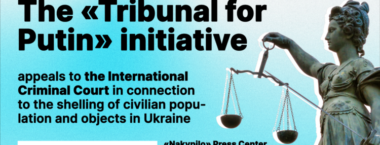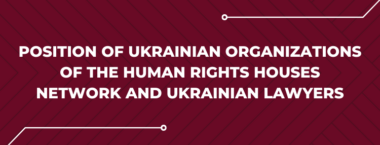“Who organized this? What the hell is this LGBT propaganda doing in our city?” a tall young man asks angrily.
“This trash has no place here!” yells another, grabbing handouts from the table and throwing them on the floor.
“There will be no LGBT propaganda in Vinnytsia!” yell the young men and pour something on the furniture and handouts. Then they leave …
What was that about?
In early February, members of the right-wing organization Edelweiss broke into the Podillya Hotel in Vinnytsia and attacked a closed training session on tolerance for journalists, pouring oil and throwing feathers at one of the coaches.
The training was supposed to be a two-day event but was canceled because of threats. Vinnytsia Oblast police launched an investigation with the preliminary classification of the offense as interference with the work of the press and hooliganism. However, it was also a hate crime. Let’s see why.
What are hate crimes?
These are crimes motivated by intolerance toward certain social groups.
According to OSCE’s Office for Democratic Institutions and Human Rights (ODIHR), such crimes have two elements: the act is a criminal offense under criminal law while the motive is bias against a certain group.
A hate crime does not necessarily mean that the perpetrator feels hate for the victim. Bias is often caused by the perpetrator’s misconceptions about a person or a group.
People perpetrators associate with the groups they are prejudiced against can also become victims of hate crimes. These can be activists, human rights defenders or journalists. Thus, anyone can become a victim of a hate crime, although most often this happens to representatives of vulnerable groups.
Ukraine’s Criminal Code contains provisions that provide for a more severe punishment for crimes committed out of prejudice (paragraph 1, Article 67).
In addition, the Code also considers prejudice as aggravating circumstances in regards to certain crimes, such as murder (paragraph 14, Article 115) or threats (part 2, Article 129).
These provisions of the law as well as Article 161 of the Criminal Code (“Violation of Equality of Citizens Based on Race, Nationality or Religion”) contain such protected characteristics as race, nationality and religion. This means that the punishment for most crimes can be stricter if the court finds that the crime was committed out of racial, national or religious intolerance.
How to identify a hate crime
According to Ukrainian Helsinki Human Rights Union expert Maksym Petrov, the existence of prejudice, which would suggest that a crime is a hate crime, must be confirmed by specific circumstances.
First of all, the victim or a witness must perceive the crime as an act dictated by prejudice. It’s also important whether the suspect was making any comments about certain groups at the time, or using certain gestures.
“It’s necessary to check whether the suspect and the victim belong to different races or ethnicity and whether they have different religions and sexual orientation. Also, was there any enmity between their respective groups in the past? Does the victim belong to a group that is in the minority compared to that of the suspect in the place whether the crime took place?” shares Maksym Petrov.
Another important factor is whether the crime was carried out by an organized group with hateful views, and whether the evidence found at the crime scene suggests that the crime was committed by an extremist nationalist group or organization.

Who suffers from hate crimes the most
According to the ODIHR, in Ukraine the following groups become victims of hate crimes most often:
- foreigners and members of ethnic minorities;
- members of religious minorities, along with their property (churches, synagogues, mosques, cemeteries) and private belongings;
- Roma people;
- gays, lesbians, bisexual and transgender persons; members of these communities often become targets, especially since there is no law that would provide them with adequate protection. They are often attacked in public, including LGBT rights activists.
Statistics on hate crimes in Ukraine
In January-December 2019, Ukraine’s Prosecutor General’s Office registered 184 criminal offenses committed on the grounds of racial, national or religious intolerance, but 85 cases were closed without trial.
According to the statistics of Ukrainian courts, in 2019 9 court proceedings were initiated under Article 161 of the Criminal Code, with 10 persons having been put on trial. By the end of the year only 4 of them were convicted in 4 cases, while the other 4 cases are still being examined.
At the same time, LBGT organization Nash Mir documented in 2019 369 acts committed out of homophobia and transphobia as well as other violations of LGBT rights in Ukraine. Most of the victims were LGBT residents of major cities where they are more conspicuous: Kyiv, Kharkiv, Odesa as well as Kherson.
According to human rights defenders, the situation with investigations of homophobia or transphobia-related hate crimes remains extremely poor. Investigators have consistently ignored these motives, instead classifying crimes as common hooliganism or other minor offenses and refusing to apply Article 161 of the Criminal Code which is currently the only way to account for hate motives in sentencing.
Even when investigators are forced to open an investigation under Article 161, it never results in convictions under this article in court. The current criminal law is completely unsuitable for accurate classification of hate crimes based on grounds other than race, nationality/ethnicity or religious affiliation.
How police deal with hate crimes
According to Kostiantyn Tarasenko, head of the Human Rights Department of Ukraine’s National Police, police officers undergo thorough training on hate crimes. Thus, all future police officers take a course entitled Combating Intolerance and Discrimination as part of their training.
According to the representative of the police, a series of trainings for police officers will be held in 2020 with the support of KyivPryde. There are also preliminary arrangements for trainings that will be conducted by the Roma Women Fund Chirikli.
Mr. Tarasenko also mentioned that cadets have been issued new handbooks:
“There are two – Categorizing and Investigating Hate Crimes in Ukraine and Using Bias Indicators: A Practical Tool for Police. They are used by cadets in some schools of the Ministry of Internal Affairs as well as by officers undergoing professional advancement training.”
At the same time, notes Maksym Petrov, the guidelines developed by the Chief Investigative Directorate of the Police are far from comprehensive. Thus, they make no mention of such grounds as sexual orientation or gender identity.
“Although these indicators are in the ‘other’ category under Article 161 of the Criminal Code, they nevertheless are among the most common motives for hate crimes in Ukraine,” he says.
Kostiantyn Tarasenko also shared that in order to make their records on hate crimes more complete, investigative departments of the police in regions and the capital appointed officers responsible for monitoring reports that would suggest discriminatory motives in the actions of perpetrators. These reports are also forwarded to the Chief Investigative Directorate for consolidation.
“Police keep records of hate crimes committed on the grounds of racial, national or religious intolerance. There are also handpicked records on crimes committed out of prejudice toward the LGBT community and persons with disabilities. Because it’s the Prosecutor’s Office that maintains official statistics,” says Mr. Tarasenko.
There is, however, no statistics for 2019 yet, he adds.
Why the police should keep hate crimes high on their priority list
Hate crimes tend to get more numerous and violent since the perpetrators believe that their actions are morally justified, as stressed by the ODIHR in their handbook Understanding Hate Crimes.
Hate crimes tend to escalate: offenders who start by committing minor crimes often go on to commit increasingly violent acts if they are not caught and stopped.
Hate crimes can easily spiral out of control. While they affect individuals, the entire communities to which these individuals belong to end up suffering, as they also receive the message of hate.
Breaking this vicious circle and bringing peace to the victim’s community requires decisive action on the part of the authorities as well as awareness-raising campaigns.
In particular, as Maksym Petrov mentions, his own organization as well as other human rights initiatives hold regular trainings on hate crimes for police officers. However, it’s still not enough, as he firmly believes.
The activist says it’s time to revise police training and skill advancement programs, expanding them with such issues as human rights, non-discrimination and investigation of hate crimes, including SOGI-related ones, while taking into account OSCE’s recommendations.
“Once these crimes start being classified as hate crimes, we’ll be able to say that our awareness-raising efforts have taken effect,” he concludes.
Text by Lisa Kuzmenko
Prepared with the support of Freedom House Ukraine




